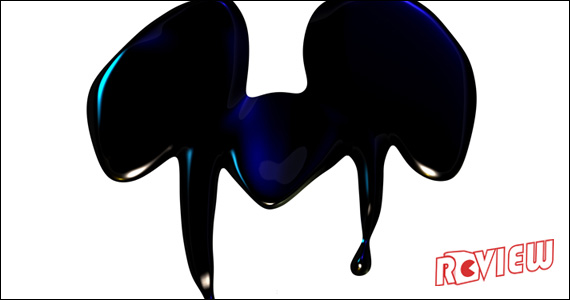
The Wasteland is a refuge, a place where forgotten cartoon characters can live on within Junction Point Studios’ heartfelt tribute to the house that Mickey Mouse built. Freed from ownership by Universal Studios, even Oswald the Rabbit can find new purpose in this place, acting as both mascot and ruler for this world, providing shelter for his fellow ‘toons while obsessing over the popularity of Walt’s favorite son.
The sincerity drips from every digital brush stroke, and remarkable seems like a word worth using to describe the amount of attention given to the details. Junction Point has created a living, breathing world for characters few players are likely to readily remember. But the devil in those details is whether this labor of love offers an opportunity and incentive for players to truly immerse themselves in this world, or if this epic undertaking merely offers a lightly pulsing museum, one which assumes that the care of content can counterbalance significant design problems, which Disney Epic Mickey unfortunately offers in spades.
If this quick appraisal leaves you making a sad face beneath your Mouseketeer hat, join the club.
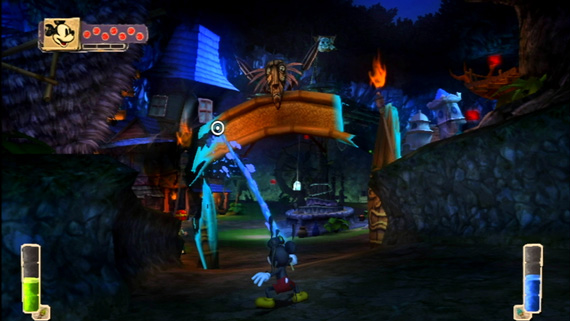
The game disc offers the opportunity to unlock and watch an Oswald the Rabbit cartoon, a chance to appreciate the connection shared between the animation and gaming medium. Watching Oswald attempt to rescue a princess in waiting, it’s impossible to not still see the charm in the exaggerated movement characters exhibit. There’s a joy of movement there as the priority, the central draw over which all other concerns are layered.
Incidentally this is how I also see that great defining title of the videogame medium, Super Mario Bros., a game that even under the constraints of technological limitations was successful in the way it gave the sensation of joyous movement to the player. It’s still as much a joy to watch Mario jump and move, more so to know and feel your connection to causing it – comparable to the same amount of joy found in watching Oswald take to the screen so many years later.
Given the history of Disney animation, that joy of movement is the burden, the primary job of any videogame looking to explore the rich content of that dynasty. This would be the case whether we were discussing a current release, or waxing nostalgically on dated titles from the Sega Genesis. As for how this comes together within Disney Epic Mickey, an example is definitely in order.
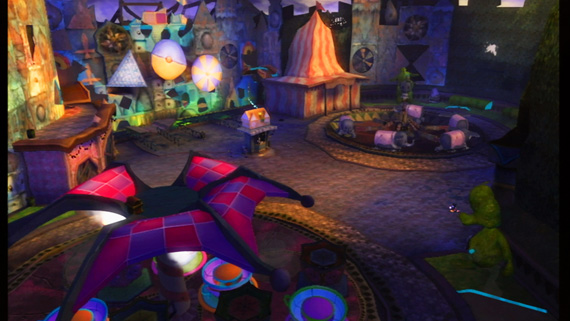
During Mickey’s quest through the wasteland player’s will encounter a series of themed areas that offer pockets of challenges – collecting objects, talking with and aiding characters, and solving puzzles that open the path forward to more still more areas. And yet the greatest challenge in each of these areas is caught between rotating the camera to see the entirety of these spaces, and positioning it in a way that allows for the platforming required.
At one point I climbed a series of platforms to reach the peak of a tower, simply because only at that highest point could I fully rotate the camera around the stage to take in the sights. From that vantage point I spotted another lower platform near a roof I needed to reach. But as I jumped from my perch to that platform, the camera hit the wall and spun away, making any chance of landing successfully a complete game of chance. And even though there is a first-person mode that can be activated as a potential solution to this problem, the camera is rarely willing to cooperate, leaving the places capable of activating said mode not as desperately in need of the aid.
And would you believe that such a simple and familiar control gripe invades every inch of the adventure until you just don’t want to play anymore?
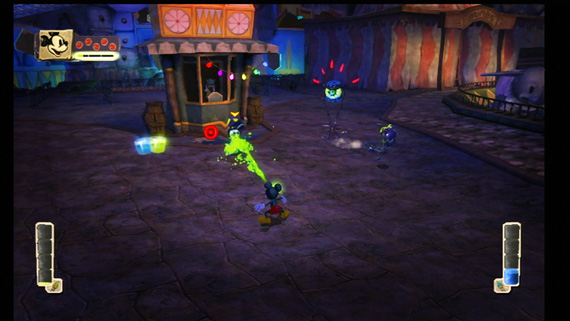
I’ve been apologetic of control issues in other titles, and I hate to be that guy, but it’s 2010, Super Mario Galaxy 2 exists, and I can’t honestly recall ever fighting with a camera so much in my gaming memory. The bottom line is that admiring the attention to detail given to the content, and marrying that with these control problems, makes it hard to come to any other conclusion than Junction Point treated how the player would interact with this world as an afterthought to the design, and no matter how wonderfully detailed your world is, if the player can’t explore it without repeated aggravations, the experiment is a failure.
Odder still are the 2D sequences that held the most hope for me prior to playing the final release. Classic Disney cartoons have been turned into sidescrolling segments, which act as gateways between the 3D areas of the game. Players pass through the amazingly recreated environments of Steamboat Willie and other cartoons, not able to overtly interact with these environments, but experiencing them in a relevant way to the themes of the game.
And yet even here the controls feel off, with a lagging feeling that has Mickey simply passing through these spaces rather than demonstrating the joy of movement that made those cartoons so special for their time. And despite the charm of animation occurring in these sequences, experiencing them more than once quickly degrades the significance and value.
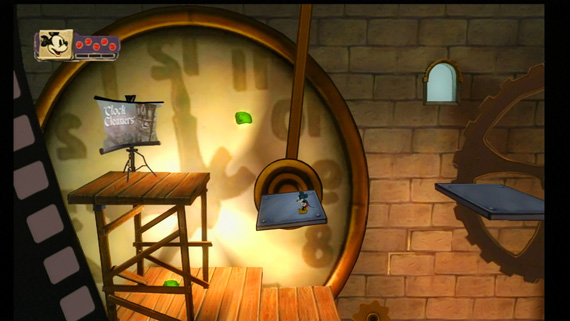
The game eventually devolves into a strange series of fetch-quests, tasks unquestionably meant to stretch out the playtime and add the lightest sense of exploration to The Wasteland. Players will travel between areas to deliver or search out items, lacking any real inventory system and essentially running toward characters to engage in obligatory conversations that swap one item for another, with varying degrees of significance to the story, and at many times without real warning – I’m sorry Pete, I didn’t know you needed that book back!
A pirate may desire flowers to impress a would-be lover, leaving Mickey searching for flowers, but then quickly derailed to deliver a pie, fumbling between areas and quickly losing the point of the entire endeavor. And through all of this, Mickey uses those 2D tunnels as a passage, until you’ve passed through the looking glass so many times that you vomit a deck of cards and lose the final shreds of interest in collecting another single e-ticket – The Wasteland’s primary currency.
The stake in the heart of this beast are paint mechanics that leave the player struggling to find a harmony between using paint to create and add to the world, or thinner to dissolve it – not unlike the dip from Who Framed Roger Rabbit. While each area is sorely in need of a dab of color, the majority of what the player does resets each time they enter an area, save for tasks that specifically move the game forward, which dramatically affects the desire to interact at all, and perhaps feeds a cynicism that makes it more fun to dissolve characters into a blob.
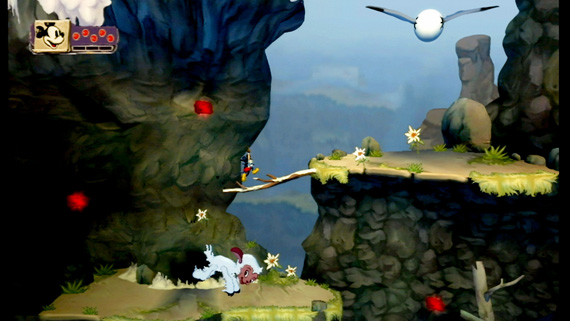
Aiming the paint or thinner becomes a game all its own, one that often requires excessive movement to so much as fill in the holes of a bridge – deducing the drop distance of a paint stream becomes essential to sanity while trying to find any harmony with the camera controls.
The choice between paint and thinner plays into that other draw of this release, the much sought after Holy Grail of game design that convinces players that their choices play a significant role within the game sphere. It likely won’t surprise many that this is no greater a realization here than in any other lofty title hoping to convince the player that their actions have real consequences. There are many moments of choice, often lingering on whether Mickey will take an easy route to his objectives or run around performing additional tasks to be the hero The Wasteland needs and his reputation suggests he is.
I’m going to suggest that the aggravations listed above make it impossible not to take the easier road after a time, but I don’t want to go so far as saying that choice is inconsequential. The results are often direct, whether you decide to paint enemies to make them allies, watching as they immediately attack other enemies, or spare a boss in battle and have a relative of his give you a bonus. What’s in it for you to play it nice isn’t some mystery that builds and makes you feel all warm and fuzzy for having a moral compass by the end, but it isn’t so simple as gaining scars for being a badass either.
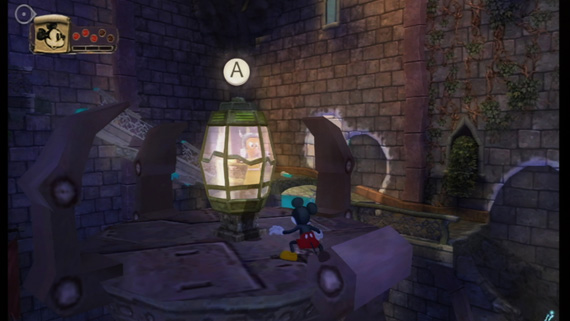
The most visible consequence of whether you use the paint or thinner more is a gauge in the top of the screen, which affects sprites the can be set upon enemies, at least on occasions where you can get the Wii Motion controls to cooperate as you “flick” said sprites into action.
Any sense of really being able to take control and have effect on this world is a fallacy. There is no investment to be made, no rewards that encourage taking the time to either rebuild or destroy The Wasteland, but rather a series of tasks painfully laid out by a handholding agenda overseen by guardian characters, so that in the end you’re just pushing toward inevitable conclusions. It’s unfortunate given the expectations built by this project overtime, not only because this release is incapable of living up to the very hopes its initial announcement produced, but because it proved that such a hope existed, that gamers really do want a mature and evolving conception of Disney in their lives. Based on the results herein, we’re still left waiting, and unfortunately it may be a long time before anyone gets the chance to offer that to gamers again.
The salt in the wound is that beneath the generic Tim Burton flavored atmosphere and the facade of choice hoping to mask authoritarian direction and control, we’re left inspired and imagining what could have been, which makes the idea of forcing a path through this release for the content alone more of a tease than a lingering incentive.
Junction Point Studios
Publisher
Disney Interactive Studios
System
Nintendo Wii
Modes
Singleplayer
Release Date
November 30, 2010
*A copy of this title was provided by the publisher for review
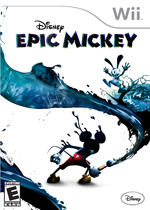
Ouch. I wasn’t looking forward to it anyhow (and not just because it used the lame ass word “Epic” in the title)… but… ouch. I assume I wouldn’t be able to play it anyways as it probably uses the Nunchuck to move… :\
Comment by Ujn Hunter — December 1, 2010 @ 11:05 am
It does.
In semi-related lefty news, I started playing flingsmash and it is nice enough to ask which hand you use, I thought you’d appreciate that.
Comment by Jamie Love — December 1, 2010 @ 11:40 am
Finally, a game that Ujn can enjoy and it’s only $10!
Comment by EdEN — December 3, 2010 @ 8:47 pm
@Ujn: Yep, Nunchuk moves Mickey and thus your southpaw gently weeps.
Thanks for the review Jamie since it’s very informative. I tried a demo for it and like it enough as to pre-ordered the CE for Epic Mickey. I’ll be picking it up over the weekend.
Comment by EdEN — December 1, 2010 @ 11:58 am
Hey Ujn has an avatar, who knew!
Comment by Jamie Love — December 4, 2010 @ 12:41 am